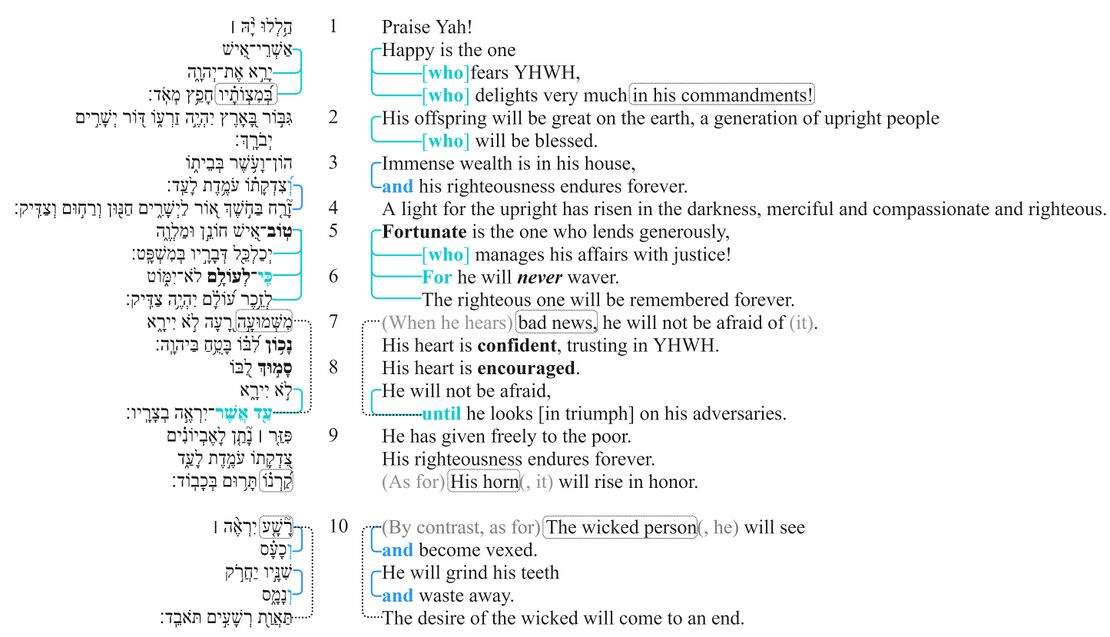Psalm 112 Macrosyntax
From Psalms: Layer by Layer
Psalm 112/Macrosyntax
Choose a PsalmNavigate Psalm 112
Macrosyntax
Macrosyntax Diagram
| Macrosyntax legend | |
|---|---|
| Vocatives | Vocatives are indicated by purple text. |
| Discourse marker | Discourse markers (such as כִּי, הִנֵּה, לָכֵן) are indicated by orange text. |
| The scope governed by the discourse marker is indicated by a dashed orange bracket connecting the discourse marker to its scope. | |
| The preceding discourse grounding the discourse marker is indicated by a solid orange bracket encompassing the relevant clauses. | |
| Subordinating conjunction | The subordinating conjunction is indicated by teal text. |
| Subordination is indicated by a solid teal bracket connecting the subordinating conjunction with the clause to which it is subordinate. | |
| Coordinating conjunction | The coordinating conjunction is indicated by blue text. |
| Coordination is indicated by a solid blue line connecting the coordinating clauses. | |
| Coordination without an explicit conjunction is indicated by a dashed blue line connecting the coordinated clauses. | |
| Marked topic is indicated by a black dashed rounded rectangle around the marked words. | |
| The scope of the activated topic is indicated by a black dashed bracket encompassing the relevant clauses. | |
| Marked focus or thetic sentence | Marked focus (if one constituent) or thetic sentences[1] are indicated by bold text. |
| Frame setters[2] are indicated by a solid gray rounded rectangle around the marked words. | |
| [blank line] | Discourse discontinuity is indicated by a blank line. |
| [indentation] | Syntactic subordination is indicated by indentation. |
| Direct speech is indicated by a solid black rectangle surrounding all relevant clauses. | |
| (text to elucidate the meaning of the macrosyntactic structures) | Within the CBC, any text elucidating the meaning of macrosyntax is indicated in gray text inside parentheses. |
If an emendation or revocalization is preferred, that emendation or revocalization will be marked in the Hebrew text of all the visuals.
| Emendations/Revocalizations legend | |
|---|---|
| *Emended text* | Emended text, text in which the consonants differ from the consonants of the Masoretic text, is indicated by blue asterisks on either side of the emendation. |
| *Revocalized text* | Revocalized text, text in which only the vowels differ from the vowels of the Masoretic text, is indicated by purple asterisks on either side of the revocalization. |
(Click diagram to enlarge)
There are no notes on divisions for this psalm.
- v. 1b. The PP בְּ֝מִצְוֺתָ֗יו is probably fronted to fit the acrostic structure (ב line). The fronting of בְּ֝מִצְוֺתָ֗יו also creates an ABB'A' chiasm with v. 1a. In addition to these poetic effects, the fronting might also have a pragmatic effect, marking the topic of the clause. Whereas the preceding clause comments on YHWH, the present clause shifts the topic to that of his commandments.
- v. 2. The predicate complement גִּבּ֣וֹר בָּ֭אָרֶץ is probably fronted to fit the acrostic structure (ג line) (but see Lunn 2006:327 "MKD").
- v. 4. The post verbal fronting of בַּחֹ֣שֶׁךְ might be normal (cf. Isa. 58:10—וְזָרַ֤ח בַּחֹ֙שֶׁךְ֙ אוֹרֶ֔ךָ). In any case, it is normal for the heavier constituent אוֹר לַיְשָׁרִים to be placed at the end of the clause.
- v. 5. The predicate complement טוֹב is fronted to fit the acrostic structure (ט line), to strengthen the correspondence between v. 5 and v. 1 (see poetic structure), and probably also to focus the description of the man as טוֹב (cf. BHRG 47.3.2), a description which is singled out for comment in the following כי clause (v. 6, see note on כי below)
- v. 6a. The normal word order would be לֹא יִמּוֹט לְעוֹלָם (Ps. 15:5). The PP לְעוֹלָם is probably fronted for marked focus, as often elsewhere (cf. Pss. 5:12; 9:8; 30:13; 33:11; 37:18, 28; 44:9; 55:23; 89:37; 100:5; 102:13; 103:9; 125:1; cf. esp. Ps. 55:23 — לֹא־יִתֵּ֖ן לְעוֹלָ֥ם מ֗וֹט לַצַּדִּֽיק) (cf. Lunn 2006:357 "MKD").
- v. 6b. The predicate complement לְזֵ֥כֶר ע֝וֹלָ֗ם is probably fronted to fit the acrostic structure (but see Lunn 2006:327 "MKD")
- v. 7a. The PP מִשְּׁמוּעָ֣ה רָ֭עָה is probably fronted to fit the acrostic structure (מ line). It could also be read as topical.
- v. 7b. The participle נָכ֥וֹן is fronted to fit the acrostic structure (נ line) and probably also for marked focus. If the man does not respond to bad news with fear (v. 7a), then how does he respond; what is his emotional state? Verse 7b answers this question: "his heart is confident..."
- v. 8a. The participle סָמ֣וּךְ is fronted to fit the acrostic structure (ס line) and probably also for marked focus (see note on v. 7b).
- v. 9c. The S קַ֝רְנ֗וֹ is probably fronted to fit the acrostic structure (ק line). It could also be topical. Whereas v. 9b is about the man's 'righteousness', v. 9c is about his strength (i.e., 'his horn').
- v. 10a. The fronted subject רָ֘שָׁ֤ע is probably a marked topic: 'But as for the wicked...' (cf. Lunn 2006:327 "MKD").
- v. 10b. The DO שִׁנָּ֣יו is probably fronted to fit the acrostic structure (ש line) (but see Lunn 2006:327 "MKD").
- v. 10c. The placement of תֹּאבֵד ("come to an end") as the last word in the psalm is probably a poetic device used to bring closure (cf. Ps. 1:6) (but see Lunn 2006:327 "MKD").
There are no notes on vocatives for this psalm.
There are no notes on discourse markers for this psalm.
- The כִּי in v. 6 grounds the description of the man as טוב (Baethgen 1904). Why use the word fortunate to describe the man who lends generously? "Because [such a man] will never waver..." (cf. Locatell on metalinguistic causal כי—"Metalinguistic causal כי may provide the grounds for a more concrete linguistic element, like the use of a particular word" (2017:89). The semantics of v. 6b ('the righteous one will be remembered forever') suggest that it is included within the scope of כִּי (v. 6a), as an additional reason why the person is described as 'fortunate.'
- ↑ When the entire utterance is new/unexpected, it is a thetic sentence (often called "sentence focus"). See our Creator Guidelines for more information on topic and focus.
- ↑ Frame setters are any orientational constituent – typically, but not limited to, spatio-temporal adverbials – function to "limit the applicability of the main predication to a certain restricted domain" and "indicate the general type of information that can be given" in the clause nucleus (Krifka & Musan 2012: 31-32). In previous scholarship, they have been referred to as contextualizing constituents (see, e.g., Buth (1994), “Contextualizing Constituents as Topic, Non-Sequential Background and Dramatic Pause: Hebrew and Aramaic evidence,” in E. Engberg-Pedersen, L. Falster Jakobsen and L. Schack Rasmussen (eds.) Function and expression in Functional Grammar. Berlin: Mouton de Gruyter, 215-231; Buth (2023), “Functional Grammar and the Pragmatics of Information Structure for Biblical Languages,” in W. A. Ross & E. Robar (eds.) Linguistic Theory and the Biblical Text. Cambridge: Open Book Publishers, 67-116), but this has been conflated with the function of topic. In brief: sentence topics, belonging to the clause nucleus, are the entity or event about which the clause provides a new predication; frame setters do not belong in the clause nucleus and rather provide a contextual orientation by which to understand the following clause.


